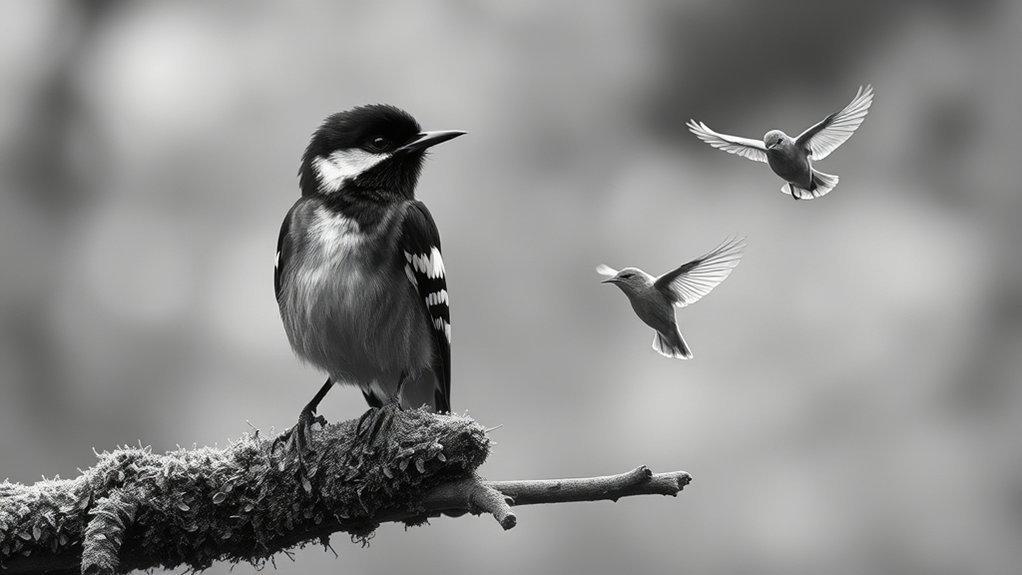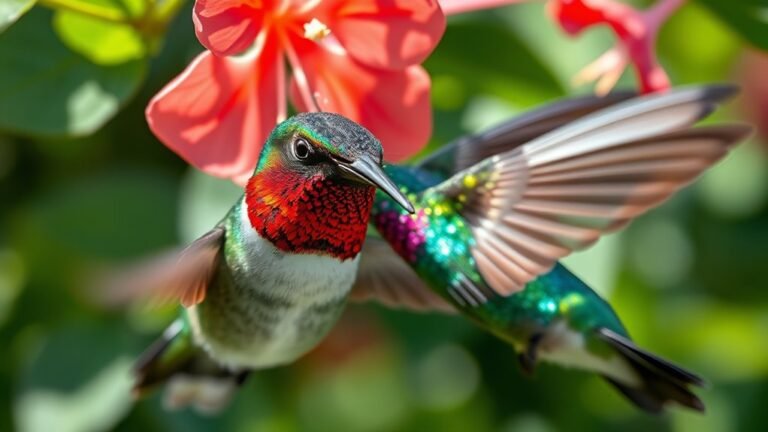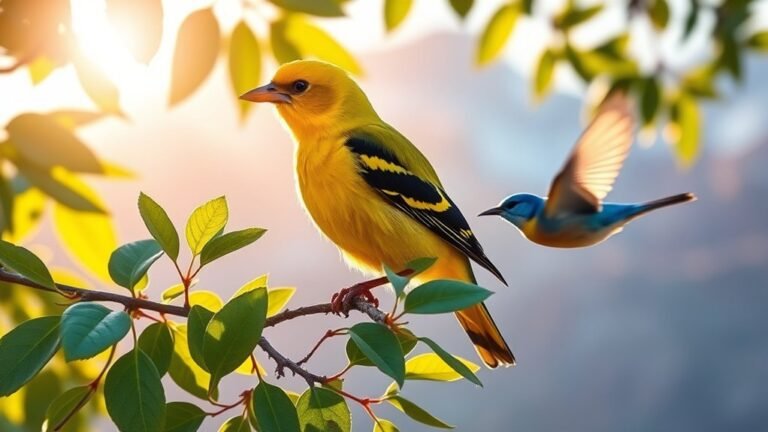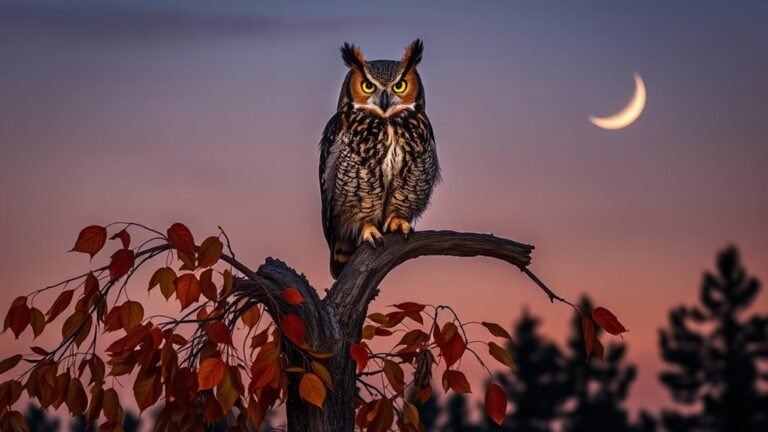30 Stunning Black and White Birds: Identification and Facts
When you look at black and white birds, you see many interesting features and behaviors. Each bird species, such as the American Avocet or Pied-billed Grebe, has its own special traits. Their black and white feathers are not just pretty; they help them hide from predators and communicate with each other.
As you learn more about these birds, you will find fun facts about how they live and behave. This can change what you think you know about birds. So, take a closer look, and enjoy discovering the amazing world of black and white birds!
A Quick Overview
- Black-capped Chickadees are friendly and adaptable birds. You can often find them in parks or gardens. They are known for their fun "chick-a-dee-dee-dee" call.
- American Avocets are beautiful with their black-and-white feathers. They live in shallow wetlands and work together to find food. They also take care of their young as a group.
- Pied-billed Grebes are interesting little birds that dive for food in marshy areas. They make unique mating calls and build their nests using nearby plants.
- Black-necked Stilts have long legs and make special calls. They like to breed in groups and search for tiny food along the edges of shallow waters.
- Rooks have shiny black feathers and enjoy living in flocks. They are clever birds that use tools to solve problems, and you can see them in both cities and farms.
American Avocet
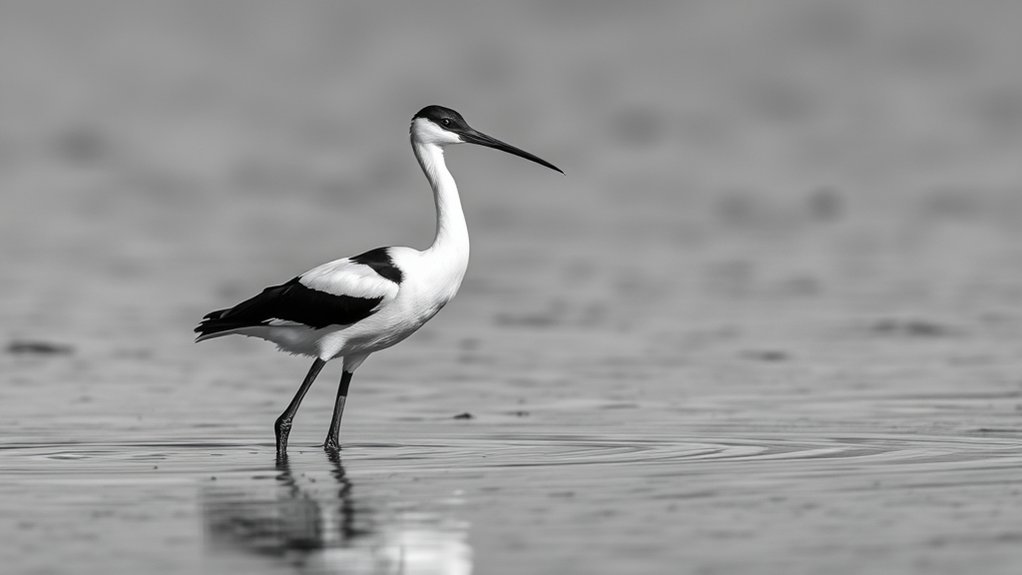
The American Avocet is a beautiful bird with striking black-and-white feathers. It lives in shallow wetlands, marshes, and coastal areas where there's plenty of food like small crustaceans and insects.
You can watch the Avocet as it feeds. It moves its long beak back and forth in the mud to find tasty treats. This bird likes to be around others, so you'll often see it in groups, working together while they look for food.
The American Avocet is also a caring parent. It builds nests in groups with other Avocets.
Knowing how these birds act and where they live helps us understand how important they're to their environment.
Black-capped Chickadee
The Black-capped Chickadee is a small and charming bird. It's about 12 centimeters long and weighs around 12 grams. You can often see this bird in deciduous forests, mixed woods, and even in city gardens. They're very adaptable and can live in many different places.
Watching Chickadees is a fun experience. They're curious and social birds. You'll see them flying in small groups. They often hide food for later, which is called food caching.
Their special call sounds like "chick-a-dee-dee-dee," and this name helps people remember them. This call also helps them share important messages with each other.
Learning about their behavior makes you appreciate these delightful birds even more. They connect us to nature and bring joy to our surroundings.
Magpie

Magpies are interesting birds with black and white feathers that shimmer in the light. They're smart and social. If you watch them closely, you'll see them interact with each other through different calls and often engage in playful behavior. Many cultures see magpies as symbols of cleverness and adaptability, linking them to themes of magic and mystery.
- Magpies build big nests in trees, showing their building skills.
- They usually live in family groups and have different social structures.
- They're known for their strong memory and problem-solving skills, which show how intelligent they are.
Learning about magpies helps you appreciate nature more and feel connected to the bird world around you.
Barn Owl
Barn owls are amazing birds that look like ghosts with their heart-shaped faces. They live in open places like fields and grasslands where they can hunt for food easily.
Their ears are super good at hearing, so they can find mice and other small animals even when it's dark outside.
When barn owls fly, they do it quietly. This helps them sneak up on their dinner without being heard.
They like to rest in tree holes, old buildings, or empty places, which shows how flexible they are.
Outside of the baby-making season, barn owls normally like to be alone. But when it's time to form families, they stick together as pairs.
Seeing a barn owl in the wild is a special experience that reminds us how important every animal is in nature.
Pied-billed Grebe
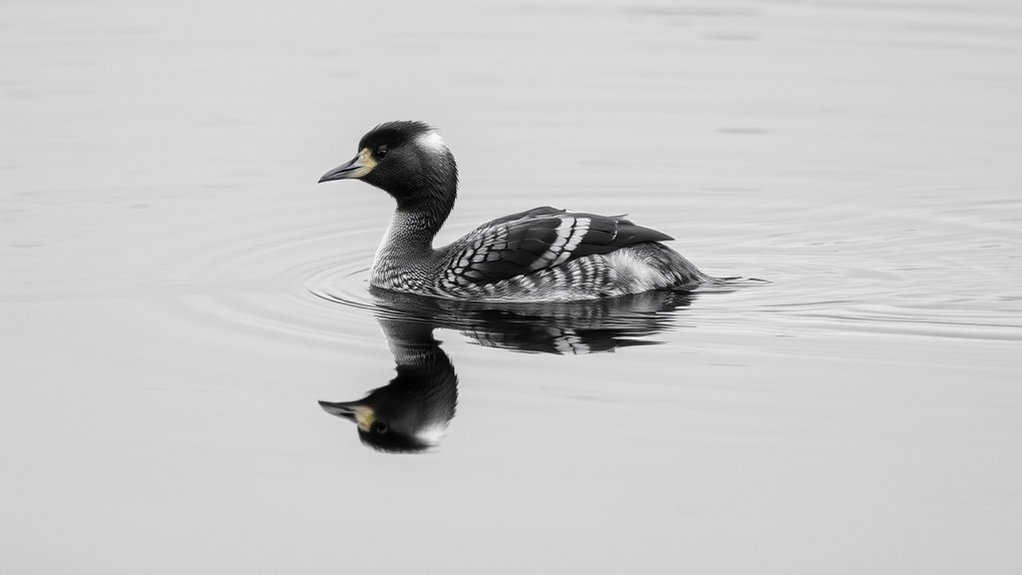
The Pied-billed Grebe is a unique bird that lives in water. It has a special look and interesting habits. You can find this small diving bird in places like marshes, ponds, and lakes all over North America. Its body is long, and its bill is thick, making it easy to recognize.
- Habitat: The Pied-billed Grebe likes shallow waters with lots of plants. This helps it build nests and find food.
- Behavior: This bird is a great diver! It can stay underwater for up to 30 seconds, looking for fish and insects to eat.
- Sounds: The Pied-billed Grebe makes special calls, especially when it's mating season. These sounds help it connect with other grebes.
Learning about the Pied-billed Grebe's home and actions helps us see why these birds matter in our water environments.
It's important to protect their habitats so they can thrive.
Common Raven
The Common Raven is a smart bird with shiny black feathers and a unique wedge-shaped tail. These birds are known for their clever behavior. They can solve problems and interact with each other in interesting ways.
Ravens often work together to find food, showing how they help one another out.
In many stories and cultures, ravens are symbols of mystery and change. People often connect them to legends and myths.
Ravens can also make many different sounds, which they use to communicate with each other, sharing important messages.
Northern Flicker
The Northern Flicker is a large woodpecker with six different color phases. These birds are known for their bright feathers and interesting ways of finding food.
You can find them in open woodlands, parks, and even in city areas where they can live close to people. They mainly eat ants, beetles, and other insects, which helps keep nature balanced.
Unlike most woodpeckers, Northern Flickers like to look for food on the ground. They've a unique call that you might hear outside.
Their colorful feathers change depending on where they live, which makes them even more special.
Learning about where Northern Flickers live and what they eat can help you enjoy watching these amazing birds.
It can also help you feel more connected to the animals in your area.
Killdeer
The Killdeer is a bird that you can often see in fields and by the shore. It's a type of plover. You can easily spot this bird because of its two black bands across its chest and its long wings.
Killdeer have some cool ways of acting. If they sense danger, they can pretend to be hurt. This broken-wing act helps to draw attention away from their nests and keeps their eggs safe.
They mostly live in gravelly or sandy places where they find their food. Their diet includes insects and small critters.
You might see them running fast on the ground, always looking out for anything that might be a threat. This ability to adapt helps them survive in different places.
Watching Killdeer in nature can help you appreciate the wonderful variety of birds we've around us.
White-tailed Kite
The White-tailed Kite is an amazing bird that grabs your attention. It has pretty white feathers on its belly and cool black patches on its wings. Juvenile Kites look a bit different—they have brown streaks and aren't as bright.
These birds hunt in a special way. They hover in the air and look for food like mice. You can usually find them in open fields and grasslands where they show off their quick moves.
One of their special features is their forked tail. This tail helps you identify them when they're flying.
As you watch these Kites, you'll see how graceful and skilled they're when hunting. The White-tailed Kite is truly a fun bird to observe!
Eastern Towhee
The Eastern Towhee is a colorful bird that many people love to watch. These birds live in places like bushes, woods, and gardens. They prefer thick underbrush, which helps them hide from predators and find food easily.
Eastern Towhees have a special way of eating. They scratch the ground with their feet to uncover seeds and insects that are hidden below. This scratching method is important, especially in spring when they need extra food for breeding.
If you take some time to observe the Eastern Towhee in its chosen habitat, you'll learn more about its important role in nature.
Watching these birds can help you feel more connected to the outdoors and appreciate wildlife even more.
Black-and-white Warbler
The Black-and-white Warbler is one of seven warbler species found in North America. This little bird is easy to spot because of its bold colors and special way of looking for food.
It loves living in areas like deciduous forests, where it climbs tree trunks to find insects hiding in the bark.
Here are some fun facts about the Black-and-white Warbler:
- Behavior: This bird climbs up tree trunks like a nuthatch, showing how well it can adapt to its environment.
- Habitat: It likes old forests with lots of leaves. These places give it plenty of cover and food.
- Songs: Listen for its lovely, repeating songs. They add to the beautiful sounds of the forest.
These details help you see how important the Black-and-white Warbler is in its home.
Woodpecker
Woodpeckers are cool birds that stand out with their bright colors and interesting habits. You can often see them pecking on trees and tapping on surfaces. They do this to talk to each other and to find insects to eat. Watching them climb and move around trees is really fun because they're very agile.
Woodpeckers live in many places, like forests, woodlands, and even parks in cities. This shows how well they can adapt to different environments. They've strong beaks that help them dig into tree bark to find tasty bugs.
Learning about woodpeckers can help you see how important they're to forests. When they drill into trees, they make homes for themselves and other animals.
Paying attention to their behaviors and habitats can help you connect to nature in a special way.
Black-throated Gray Warbler
The Black-throated Gray Warbler is a small and beautiful songbird. You can find this bird in the coniferous forests of western North America. It loves to hop around the branches to find bugs and caterpillars to eat. Watching its lively movement can be pretty fun!
- Behavior: This bird often bobs its tail and sings a lovely song.
- Habitat: It mainly lives in dense coniferous forests, especially during breeding season.
- Migration: The Black-throated Gray Warbler migrates, spending its winters in Mexico and Central America.
Getting to know the Black-throated Gray Warbler helps you appreciate these amazing creatures more. They add a special touch to our natural world!
Eurasian Magpie
The Eurasian Magpie is a fascinating bird. It lives in many different places, like forests, cities, and farms. Its shiny feathers shine with beautiful colors, which makes it easy to notice.
This bird is very smart. It can solve problems and interact well with other magpies. They often hide food to save for later, showing how they adapt to their surroundings.
When you see magpies, listen to their sounds. They communicate with each other, creating strong social ties.
The combination of their beauty and cleverness makes the Eurasian magpie an interesting bird to watch and learn about.
Snowy Owl
The Snowy Owl is a beautiful bird found in the Arctic. It has white feathers and bright yellow eyes, making it stand out. These owls live in open tundra and wide, flat areas. They hunt for food in these places. Snowy Owls can be seen in Canada, Alaska, and parts of Europe during the summer when they breed.
- They usually hunt at night and have excellent vision.
- Their favorite food is small animals like lemmings, but they'll also eat birds if needed.
- In winter, some owls move south to find more food. This shows they can adapt to different situations.
The Snowy Owl combines beauty with skill, making it a remarkable bird to watch.
California Gull
The California Gull is an interesting bird to learn about. It has striking black and white feathers and lives in coastal areas and large lakes.
These birds are very social and often fly in groups, especially when it's time to eat.
California Gulls eat a variety of foods. They like fish and small sea animals. They often look for leftovers as well. You might see them playing in the air or trying to grab food from each other, which shows how they interact in their groups.
Watching California Gulls can teach us about their role in nature. They help keep the ecosystem in balance by eating both dead and live animals.
Observing these birds along the coast and lakes is a fun way to connect with nature.
Black Skimmer
The Black Skimmer is a special bird that you can see along sandy beaches and wetlands. It has a black back and a white belly, making it look really cool. This bird has a long, thin bill. It uses its bill to skim over the water and catch small fish and tiny sea animals.
Black skimmers like to nest in groups on sandy shores. They make little scrapes in the sand to lay their eggs. These nests are important for keeping their eggs safe and helping the baby birds grow.
To help black skimmers thrive, we need to protect their habitats. Clean beaches and healthy wetlands are essential for them to find food and lay their eggs safely. By caring for these places, we can keep seeing these beautiful birds for many years to come!
Lesser Black-backed Gull
Lesser Black-backed Gulls are often found on sandy beaches. They like to hang out with black skimmers in these coastal areas.
These gulls can live in many places, from open coastlines to spots near big lakes or rivers.
What do these birds eat? They mainly go for fish and crustaceans. They also scavenge for food that people leave behind. This shows how adaptable they're when it comes to finding food.
You might see them searching for snacks along the shore or taking food from other birds.
As you learn to recognize their bright yellow legs and dark wings, you'll start to appreciate how well they fit into different environments.
Knowing more about the Lesser Black-backed Gull's home and diet can help you connect with these interesting birds. You can enjoy watching them and see how they play a part in nature.
Spotted Sandpiper
The Spotted Sandpiper is a small bird that moves in a bobbing way along shores. It likes to live near freshwater lakes and riverbanks. You can see it searching for food by poking its beak in the mud for bugs and small shrimp. It keeps moving to stay safe from predators.
- Spotted Sandpipers protect their nesting areas and chase away other birds that come too close.
- During mating season, male sandpipers show off to get the attention of females with fancy moves.
- Unlike many other sandpipers, female Spotted Sandpipers are bigger and have brighter patterns than males.
Knowing these facts helps us understand the Spotted Sandpiper better and appreciate how they fit into nature. They've interesting behaviors that make them unique!
Common Blackbird
Common Blackbirds are beautiful birds. They've shiny black feathers and sing pretty songs. You can see them in many places like gardens, parks, and woods. They like to sing to mark their territory, especially when it's time to find a mate. Their songs are rich and enjoyable to hear.
When Common Blackbirds look for food, they mostly eat insects, fruits, and seeds. They're good at finding different kinds of food. You might spot them foraging in small groups, which shows how social they are.
If you love nature, keep an eye out for these lovely birds. Watching them can help you connect with the outdoors and see the variety of birds around you.
Hooded Merganser
The Hooded Merganser is a unique duck that you can find in wooded ponds and marshy wetlands. This duck stands out with its striking look and interesting behaviors.
Males have a special crest on their head that they raise to impress female ducks during courtship.
Hooded Mergansers show some cool behaviors. They often work together when breeding and use different ways to find food. Their diet mainly includes fish, tiny water creatures, and plants that grow in the water.
These ducks are great at diving. They can go underwater to hunt for their food. Watching them dive and hunt is quite a sight!
Black-necked Stilt
The Black-necked Stilt is a beautiful shorebird. It has long, thin legs and striking black-and-white feathers.
You can often see this bird in shallow marshes, mudflats, and lagoons. It's great at finding food, which includes invertebrates, insects, and crustaceans.
When you watch the stilt, you'll see it moving gracefully. It forages by walking along the water's edge or using its long bill to dig in the mud.
These birds like to be social and often breed in groups. They help each other raise their young, which is quite special.
You'll hear their loud, unique calls as they communicate with each other. This helps them build strong friendships with other stilts.
Learning about the Black-necked Stilt is a fun way to connect with the amazing variety of birds around us.
Oystercatcher
Let's talk about the Oystercatcher, a cool shorebird that loves to hang out by the ocean.
These birds have long, strong beaks. They use these beaks to open up clams and other shellfish that live in sandy and rocky areas.
- Oystercatcher Sounds: Oystercatchers make loud and unique calls. These sounds help them stay connected with their friends in their groups.
- How They Eat: When it comes to finding food, Oystercatchers are fun to watch. They use different skills to get their meals, like tapping and prying open shells.
- Building Nests: Oystercatchers usually make their nests right on the ground. They've a smart trick – their colors help hide their eggs from animals that might want to eat them.
Learning about Oystercatchers can make you appreciate these beautiful birds and their important place in nature.
White-crowned Sparrow
The White-crowned Sparrow is a striking bird. Its black and white crown helps people recognize it easily. This small bird likes open spaces, such as grasslands and the edges of forests. These areas help them find seeds and insects to eat.
Every year, White-crowned Sparrows migrate. They travel from their breeding homes in the northern U.S. and Canada to warmer places in the southern U.S. during winter.
Learning about where they live and how they move can help you appreciate these birds more. Watching them can connect you with other bird lovers, making it an enjoyable experience for everyone.
American Pipit
The American Pipit is a charming little bird. Unlike the flashy White-crowned Sparrow, the Pipit has a simpler, elegant look. You can find these small birds in open fields and by the water. They easily adapt to different places.
American Pipits love to forage for food. They run on the ground and bob their tails as they search for insects and seeds.
These birds live in many environments. They're comfortable in grasslands and tundras. During the year, they move from one place to another. In spring and summer, they breed, and in fall and winter, they find warmer spots.
The American Pipit sings a lovely tune made of sweet notes. Their song adds to the beauty of nature.
Getting to know these details helps us appreciate how special the American Pipit is in our ecosystem.
Franklin's Gull
Franklin's Gull is a beautiful bird that stands out from other gulls. You can easily spot adults with their black heads, white eye arcs, and gray wings. Their red bills give them a unique look.
These birds love wetland areas, especially during breeding season. They make nests in groups near freshwater lakes.
Franklin's Habitat is important for raising young. These birds need plenty of food, like insects and small fish, which they find in their homes.
Their ability to live in different environments shows how strong they are. Birdwatchers and nature lovers enjoy watching Franklin's Gulls because of their interesting behaviors.
If you take the time to learn more about them, you'll appreciate these amazing birds even more!
Rook
Rooks are interesting birds that adapt well to different places. They've shiny black feathers and a unique bill shaped like a crescent. You can find Rooks in farmlands and cities. These birds like to be together, which helps them interact socially.
Rooks often build nests in groups. This makes it easier for them to connect with each other. They're also smart and use tools to get food. This shows they can solve problems.
Rooks make various sounds like clicks and rattles. These sounds help them talk to others in their flock.
When you see Rooks in the wild, watch how they act and where they live. Their behavior and environment work together, helping them survive and thrive in changing conditions.
Enjoy watching these fascinating birds!
Barn Swallow
The Barn Swallow is a beautiful bird found in North America. It has shiny blue feathers and a unique forked tail, making it easy to recognize.
These birds are very creative when it comes to building their homes. They use mud to create nests under roofs or bridges. Barn Swallows usually build these nests in pairs because they like to live in groups.
Every year, Barn Swallows travel south when the weather gets cold. They come back to North America in the spring.
Watching them fly and catch insects can be a real treat. It helps people feel connected to nature and enjoy the company of these lovely birds.
If you spot a Barn Swallow, take a moment to appreciate its beauty and graceful movements!
Black-shouldered Kite
The Black-shouldered Kite is a cool bird that stands out. It has a bold black shoulder patch that pops against its white feathers. Birdwatchers and researchers love watching these raptors. You can spot them in open grasslands or farmlands, where they look for small animals like rodents and insects.
These kites have a special way of hunting. They can hover in the air before diving down to catch their food. This shows off their great skills and balance.
You can usually find Black-shouldered Kites in Australia, parts of Africa, and the Middle East. They often stick together in pairs, hunting as a team. They build their nests in trees or bushes, picking spots where they can see well.
What makes the Black-shouldered Kite unique is its ability to live in different places. This allows them to thrive in various landscapes.
Anyone who loves birds will be fascinated by their beauty and behavior.
Red-breasted Nuthatch
The Red-breasted Nuthatch is a small bird that stands out in winter. It has bright colors and can move in exciting ways. This bird loves to live in coniferous forests, where it hides and finds insects under the bark of trees.
One cool thing about the Red-breasted Nuthatch is that it often walks down tree trunks headfirst. Not many birds do this! This special way of moving helps it look for food in cracks and crevices. It also helps the bird see its surroundings from a new angle.
During winter, you can hear their unique calls echoing through the forest. These sounds invite birdwatchers to spot these lovely little birds.
Learning about how they behave and where they live makes birdwatching more fun. It helps us connect better with nature and appreciate all its wonders.
Frequently Asked Questions
What Habitats Do Black and White Birds Prefer?
Black and white birds like to make their homes in open woodlands, coastal areas, and grasslands. These places give them good spots to nest and find food.
In open woodlands, they can easily spot insects and seeds. Along the coast, they can hunt for fish and enjoy the calm environment. Grasslands provide a lot of space for them to move around and find something to eat.
How Does Bird Coloration Affect Their Survival?
Bird color affects their survival in many ways. Darker colors help birds hide in shady places. This camouflage helps them escape from predators.
Different colors have special meanings in nature. Bright colors can attract mates or warn others about danger. For example, some birds have bright feathers to show they are healthy and strong.
Understanding bird colors shows us how nature works. Each color helps birds live and thrive in their habitats. So, next time you see a colorful bird, think about how its colors help it survive!
What Are Common Behaviors of Black and White Birds?
Black and white birds show interesting behaviors. They often perform fancy mating dances to attract partners. They also have different ways to find and catch food.
These birds like to work together when they look for snacks. For example, some birds may feed in groups, helping each other. They often show off their colorful feathers, which can help them make friends.
Do Black and White Birds Migrate?
Yes, black and white birds often migrate. They move to find new places to live when the seasons change. These birds travel long distances to find food and safe homes. This shows how well they can adjust to changes in the environment.
How Can I Attract Black and White Birds to My Yard?
To attract black and white birds to your yard, you can do a few simple things. First, set up some bird feeders. Fill them with seeds that these birds like. Good options are sunflower seeds and millet.
Next, make a cozy place for them to nest. Use natural materials like twigs, grass, and leaves. This will give them a safe spot to raise their young.

Luna is the passionate founder and author of Birds and You, a website dedicated to sharing her love for birds with fellow enthusiasts. Through her engaging articles and guides, she aims to educate and inspire others to explore the fascinating world of birds. When she’s not writing, you can find Luna observing birds in their natural habitats or sharing beautiful bird photography on Pinterest. Join her on this journey to celebrate and protect our feathered friends!

